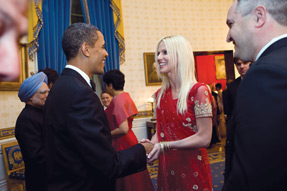Magazine
The Salahi Way

As we catalog the decade of the noughties, ring up a new contribution to our vocabulary.
| There are many theories on how the Salahis “Salahied” their way into the White House state dinner for Indian prime Minister Manmohan Singh. Security lapses, staff goof-ups, lack of “adult” supervision and a general mood of getting caught into the naughtie-ness of a couple, which could get to the most powerful seat on the planet, not to terrorize, but for simple, pure party fun. Everyone is tied up in knots trying to figure out what happened, how it happened and could it happen again.
It may, if we are allowed to find out! Perhaps the most challenging and intriguing aspect of the break-in had to do with the dress, the complexion and the mannerisms of Michaele Salahi. She was the perky one of the Virginia duo, accompanying a rather spaid, tux-wearing other-half, Tareq Salahi. The most striking peculiarity evident was her appearance. Sure, one can admire her brazenness, but the dress takes the cake, or the burfi, if you prefer.
New York Times columnist Maureen Dowd plays on this crucial aspect of the story in her piece “Who’s Sari Now?” which targeted White House social secretary Desiree Rogers, and provides the most explicit hint of how the comedy of errors worked through fashion. Most of us have seen the tirelessly repeated pictures of the modern day “Bonnie and Clyde” walking into the glare of cameras at the White House banquet. You cannot but notice the bright red whatever that Micheale Salahi was wearing that night. It is a startling Indian outfit. It seems borrowed or bought in a hurry as it does not quite fit the slim figure that Michaele maintains for her reality show try-outs.The bright red dress, one could well call it blood-red, is bound to pop in the dull and monotonous environment of Washington D.C. Red has long been the preferred color of power-housewives who want to glow in the corridors of power. It fits her body as clothes that are not made for you fit. Cholis are so particular in Indian clothing that women have them tailored or, if they get one ready-made, they have them altered to fit snugly around the body. There is enough midriff on Michaele’s waist to expose the right amount of skin, allowing more of her originality to shine through. Michaele’s skin-color screams out foreign-ness in a costume she has just picked up. To top it all, she carries herself clumsily, floating in the air like she is strutting on a college campus, waving her arms around, grinning with a sense of accomplishment at the secret that only she and her husband then knew. Tareq Salahi provided the stark contrast with his mainstream costume, and had the look of wanting to blend in even as his wife engaged the light meters on the cameras. Everything about Michaele that night was screaming for attention. Some of it had to be on her face, which proclaimed some sort of victory, underscoring the confidence of an intruder who had succeeded at her game. Ofcourse, all these interpretations come after-the-fact, as we re-read the pictures once their con has been exposed. But there is much to see through her attire, clumsy body-language and glaring claim of being “authentically” Indian or at least a friend of India and Indians. She went through the trouble to look Indian, a classy move considering it was a state dinner for the Indian Prime Minister. Anyone even slightly empathetic to the ethos of the evening had to be sensitive to India and she surely did her share. If this event had hosted the King of Saudi Arabia, Michaele would have surely donned appropriately Saudi garbs, culture and customs. It is clear that her efforts paid off with the dinner crowd, even the security guards who gleefully posed for pictures with her, as well as Vice President Joe Biden, who obliged her with a warm and friendly embrace. The weasels and slobs of Washington, D.C., seem to take her act for what it was – a genuine declaration of allegiance to a culture that has to be easy to adapt and mimic. Let the fools be fools; we want to be in our own acts.
One wonders whether Michaele would have succeeded by wearing conventional Western clothing that night. She would have made her buddy Tareq more nervous and nosy security guards just might have pursued their bona fides more closely. One way to interpret Michaele’s strategy that night is to see her dress as the first move to learn about India. It is like walking into an Indian restaurant for a buffet lunch. Many Americans claim to know a little bit of India this way. The first step always matters, especially if it is the beginning of a long, purposeful journey. For all this hoopla about the gate-crashing couple, we see little appreciation of the couple’s talents in their selections of clothes, gestures, and postures to establish connections with India. It is insulting that such grand, magnanimous gestures of authenticity and cross-cultural understanding should be allowed to fade into obscurity in the age of Obama when the mantra of global relations is dialog, conversation and exchange. We are caught between rewarding them for their wonderful efforts and prosecuting them for their brazen breach of security in the age of terror. |


